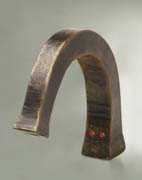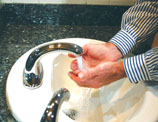
A few years ago, I was asked to predict the future in plumbing. I made a statement regarding the use of electronic automatic faucets. In discussion with the president of one of the faucet manufacturers, he commented that my prediction was far too ambitious. Well, as it turns out, we were both wrong.
I grossly underestimated the explosion that would occur in the use of electronic faucets. I don't think either one of us could have predicted how good the manufacturers would get with the technology of automatic faucets.
As one of the manufacturers stated to me, we all use the same technology; there is nothing unique. Well, that isn't completely true. It is correct that they all use the same basic technology. It is what they do to expand upon that technology that is different.
The basic technology is an infrared light beam. The light beam is interrupted by an individual's hands, which sends a reflection back, indicating that the faucet should open the solenoid valve. From this basic technology, the manufacturers expand the various options for operating the faucet.
The main concern for any faucet is the location of an individual's hands when the faucet turns on. At a demonstration, a sales representative swung his hands in from the outside (left and right side of the lavatory) and placed them immediately under the faucet. The faucet did not turn on. For this manufacturer's product, the interruption of the light beam had to be when one approaches the faucet with their hands coming from the front of the lavatory. Of course, the sales representative was picking on a competitor's product. My immediate thought was how many people swing their hands out wide when they approach a lavatory.

Sensor Location
The two most common locations of the sensors are within the spout of the faucet and deck-mounted alongside the faucet. Wall-mounted sensors for faucets are quickly disappearing, although it should be noted that some manufacturers still offer wall-mounted sensors as an option. Engineers tend to prefer specifying faucets having sensors within the spout of the faucet. There is a greater perception that these faucets will work better.It is not the location of the sensor that dictates how well the faucet operates and opens when necessary. The real key to the operation (and opening) of the faucet is the way the faucet is programmed.
Many of the original faucets had few options for programming the faucet. The sensor and connecting controller program were normally preset. When one's hands were placed in the preset location, the faucet activated; when they were not, the faucet would not turn on.
To this day, it is not uncommon to see an individual do the "hand dance" under the faucet trying to get the faucet to activate. With his hands covered in soap, he swings, raises and lowers his hands in an attempt to coax the faucet to open. In frustration, the hand dance normally continues to the adjacent faucets until one finally turns on.
Programmable Sensors
The better electronic faucets now come equipped with programmable features for opening a faucet. These features add a lot of flexibility to the faucet installation. Some manufacturers provide hand-held units to program the faucet after installation. The hand-held unit also can be used to test and/or maintain the faucet.The more important programming feature is always going to be the location of the hands to turn on the faucet. The range of sensing the hands can be from very close to a few inches away from the spout. The variation allows for the installation of the faucet on a variety of lavatories, from small round bowls to deeper square bottom bowls.
When installing the faucet, each manufacturer has a slightly different means of setting the opening range of the sensor. I recently had to experience a faucet that a contractor set at 1 inch below the spout for the opening range. That may sound good on paper, but try to place your hands 1 inch under a spout - it feels very unnatural. Plus, you are almost touching the spout, which is something people don't want to do in a public restroom.
Some manufacturers have a delay opening aspect to the program. This is a feature I detest as a user of electronic faucets. You may think that two seconds is a short period of time, but try placing your hands under a faucet for two seconds. It seems like an eternity. Many people start the hand dance and move to the next faucet.
My preference is an automatic-on with the program set up for the time interval between each use. Once the water is turned on, the controller program can set up the length of time that the water discharges. This feature can be used to meet the federal requirements for water conservation.
A standard lavatory for public use is limited to a flow rate of 0.5 gpm. However, if you limit the cycle of the faucet to a total discharge of 0.25 gallons, you can have any flow rate. Hence, if you use an aerator with a flow rate of 1.5 gpm, the maximum cycle for the faucet can be programmed to 10 seconds. Most faucets will allow any range up to 30 seconds of discharge. Then the water turns off until the faucet is reactivated.
Another programmable feature is the range of distance to turn-off the faucet. Normally, the turn off range is further away than the turn-on range. This allows an individual the opportunity to wash their hands with soap. This is also a feature that is often forgotten by the installer.
Since the faucets are simply an on/off type of faucet, the temperature of the discharging water can be controlled. Some better faucets have the temperature adjustment programmed into the controller. Thus, for a doctor's office, a higher temperature of water can be used for washing one's hands. For public lavatories, a lower temperature can be selected to prevent any scalding.
Battery Of Central Transformer
The three means of controlling electronic faucets are battery-powered, individual plug-in and central transformer type. In a recent survey by our sister magazine, PM Engineer, the favorite power supply by the plumbing engineers was the central transformer; coming in second was the individual plug-in, with battery type being the least favorite. The reason engineers prefer the central transformer is because they often are designing electronic faucets for public toilet rooms that have multiple lavatories. Thus, a single transformer can serve all of the lavatories in the individual toilet room.With central transformers, there is also less likelihood of someone stealing the connection cord to the faucet. I went into one new installation and found a number of cords for plug-in faucets missing. I'm not sure if they intended to use them for computer games or faucets in their own building.
Another benefit of the central transformer or plug-in faucet is that there are no batteries to monitor or change. This increases the reliability of the faucet. Battery-operated faucets tend to be used when there is a single faucet installation. This would occur in single-use toilet rooms often found in fast food restaurants and smaller office buildings.
The use of electronic faucets will continue to explode. Next on the horizon is residential electronic faucets. A residential electronic lavatory already is available by one of the major faucet manufacturers. That will be one way to make sure children wash their hands after going to the bathroom. Residential kitchen faucets may be next. Imagine the flexibility in the kitchen when cooking a gourmet meal.
